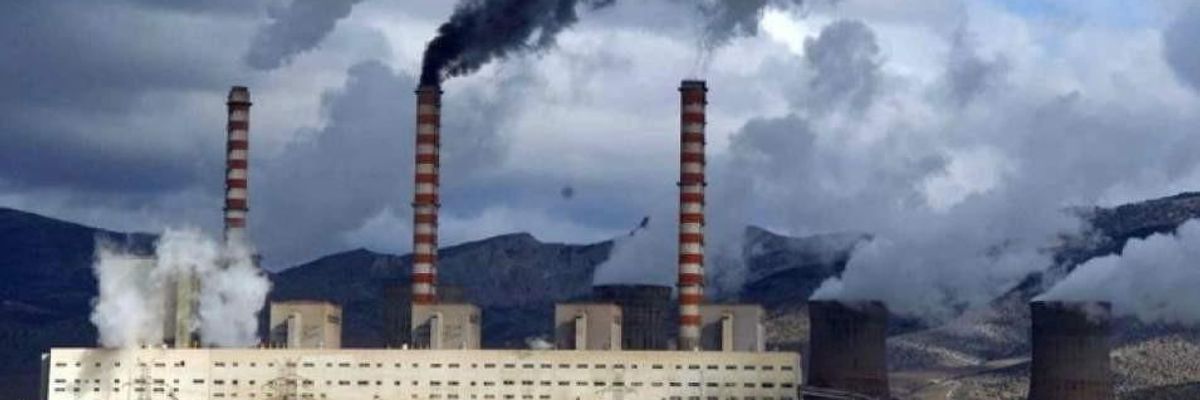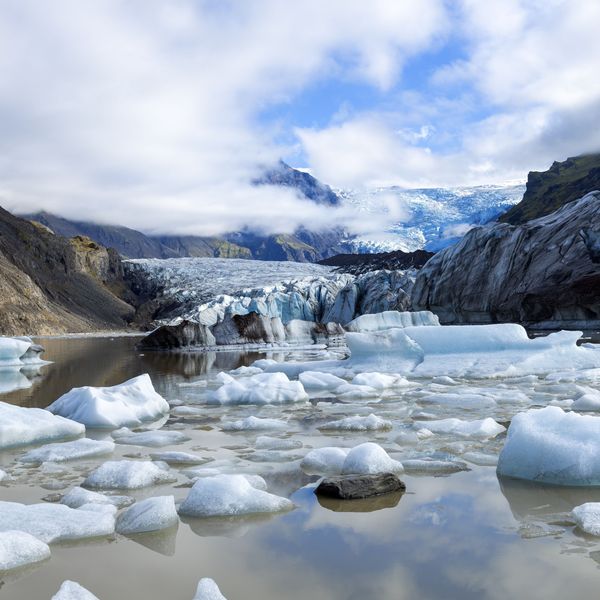
Jan Zalasiewicz, chair of the Anthropocene Working Group, said that while we are still technically in the Holocene, "in reality many important geological conditions of Earth are now outside the envelope of conditions that have characterized the great bulk of the Holocene." (Photo: Friends of the Earth)
From Nuclear Debris to Dying Coral, Scientific Panel Votes to Recognize the Destructive Impact of the 'Anthropocene'
Most members of the Anthropocene Working Group believe the "age of man" began around the mid-twentieth century, when industrialization accelerated and nuclear weapons were used by the United States
In a step toward formally recognizing that humankind--with its incessant burning of fossil fuels, use of nuclear weapons, and more--has dramatically altered the state of planet Earth, a panel of prominent scientists voted last week to designate a new geological epoch titled the "Anthropocene."
The 34-member Anthropocene Working Group (AWG) is expected to submit a proposal to the International Commission on Stratigraphy to officially recognize the Anthropocene--which means "age of man"--by 2021.
According to Nature's Meera Subramanian, 29 members of the AWG voted "in favor of starting the new epoch in the mid-twentieth century, when a rapidly rising human population accelerated the pace of industrial production, the use of agricultural chemicals, and other human activities."
"At the same time," Subramanian reported, "the first atomic-bomb blasts littered the globe with radioactive debris that became embedded in sediments and glacial ice, becoming part of the geologic record."
Last week's vote, which was over a decade in the making, was just the first step in the process of formally recognizing the Anthropocene epoch.
The AWG is now tasked with identifying a "golden spike," a geological marker that best identifies the dawn of the "age of man."
As Subramanian reported, the AWG
is considering ten candidate sites from around the globe, including a cave in northern Italy, corals in the Great Barrier Reef and a lake in China. Next week, many of the scientists involved will gather in Berlin to coordinate the next two years of research. They hope to identify a single site to include in their formal proposal. They must also define the type of physical evidence in the sedimentary record that represents the start of the epoch. The group is considering whether to choose the radionuclides that came from atomic-bomb detonations from 1945 until the Limited Nuclear Test Ban Treaty of 1963.
Jan Zalasiewicz, geologist at the University of Leicester and chair of the AWG, told Inverse that while we are still technically in the Holocene--an epoch which began around 12,000 years ago--"in reality many important geological conditions of Earth are now outside the envelope of conditions that have characterized the great bulk of the Holocene."
"Getting an official designation of the Anthropocene would reflect this new reality," said Zalasiewicz, "and help us analyze it more effectively."
An Urgent Message From Our Co-Founder
Dear Common Dreams reader, The U.S. is on a fast track to authoritarianism like nothing I've ever seen. Meanwhile, corporate news outlets are utterly capitulating to Trump, twisting their coverage to avoid drawing his ire while lining up to stuff cash in his pockets. That's why I believe that Common Dreams is doing the best and most consequential reporting that we've ever done. Our small but mighty team is a progressive reporting powerhouse, covering the news every day that the corporate media never will. Our mission has always been simple: To inform. To inspire. And to ignite change for the common good. Now here's the key piece that I want all our readers to understand: None of this would be possible without your financial support. That's not just some fundraising cliche. It's the absolute and literal truth. We don't accept corporate advertising and never will. We don't have a paywall because we don't think people should be blocked from critical news based on their ability to pay. Everything we do is funded by the donations of readers like you. Will you donate now to help power the nonprofit, independent reporting of Common Dreams? Thank you for being a vital member of our community. Together, we can keep independent journalism alive when it’s needed most. - Craig Brown, Co-founder |
In a step toward formally recognizing that humankind--with its incessant burning of fossil fuels, use of nuclear weapons, and more--has dramatically altered the state of planet Earth, a panel of prominent scientists voted last week to designate a new geological epoch titled the "Anthropocene."
The 34-member Anthropocene Working Group (AWG) is expected to submit a proposal to the International Commission on Stratigraphy to officially recognize the Anthropocene--which means "age of man"--by 2021.
According to Nature's Meera Subramanian, 29 members of the AWG voted "in favor of starting the new epoch in the mid-twentieth century, when a rapidly rising human population accelerated the pace of industrial production, the use of agricultural chemicals, and other human activities."
"At the same time," Subramanian reported, "the first atomic-bomb blasts littered the globe with radioactive debris that became embedded in sediments and glacial ice, becoming part of the geologic record."
Last week's vote, which was over a decade in the making, was just the first step in the process of formally recognizing the Anthropocene epoch.
The AWG is now tasked with identifying a "golden spike," a geological marker that best identifies the dawn of the "age of man."
As Subramanian reported, the AWG
is considering ten candidate sites from around the globe, including a cave in northern Italy, corals in the Great Barrier Reef and a lake in China. Next week, many of the scientists involved will gather in Berlin to coordinate the next two years of research. They hope to identify a single site to include in their formal proposal. They must also define the type of physical evidence in the sedimentary record that represents the start of the epoch. The group is considering whether to choose the radionuclides that came from atomic-bomb detonations from 1945 until the Limited Nuclear Test Ban Treaty of 1963.
Jan Zalasiewicz, geologist at the University of Leicester and chair of the AWG, told Inverse that while we are still technically in the Holocene--an epoch which began around 12,000 years ago--"in reality many important geological conditions of Earth are now outside the envelope of conditions that have characterized the great bulk of the Holocene."
"Getting an official designation of the Anthropocene would reflect this new reality," said Zalasiewicz, "and help us analyze it more effectively."
In a step toward formally recognizing that humankind--with its incessant burning of fossil fuels, use of nuclear weapons, and more--has dramatically altered the state of planet Earth, a panel of prominent scientists voted last week to designate a new geological epoch titled the "Anthropocene."
The 34-member Anthropocene Working Group (AWG) is expected to submit a proposal to the International Commission on Stratigraphy to officially recognize the Anthropocene--which means "age of man"--by 2021.
According to Nature's Meera Subramanian, 29 members of the AWG voted "in favor of starting the new epoch in the mid-twentieth century, when a rapidly rising human population accelerated the pace of industrial production, the use of agricultural chemicals, and other human activities."
"At the same time," Subramanian reported, "the first atomic-bomb blasts littered the globe with radioactive debris that became embedded in sediments and glacial ice, becoming part of the geologic record."
Last week's vote, which was over a decade in the making, was just the first step in the process of formally recognizing the Anthropocene epoch.
The AWG is now tasked with identifying a "golden spike," a geological marker that best identifies the dawn of the "age of man."
As Subramanian reported, the AWG
is considering ten candidate sites from around the globe, including a cave in northern Italy, corals in the Great Barrier Reef and a lake in China. Next week, many of the scientists involved will gather in Berlin to coordinate the next two years of research. They hope to identify a single site to include in their formal proposal. They must also define the type of physical evidence in the sedimentary record that represents the start of the epoch. The group is considering whether to choose the radionuclides that came from atomic-bomb detonations from 1945 until the Limited Nuclear Test Ban Treaty of 1963.
Jan Zalasiewicz, geologist at the University of Leicester and chair of the AWG, told Inverse that while we are still technically in the Holocene--an epoch which began around 12,000 years ago--"in reality many important geological conditions of Earth are now outside the envelope of conditions that have characterized the great bulk of the Holocene."
"Getting an official designation of the Anthropocene would reflect this new reality," said Zalasiewicz, "and help us analyze it more effectively."

